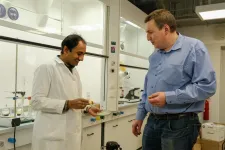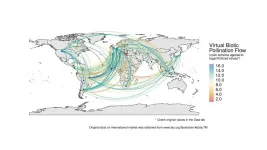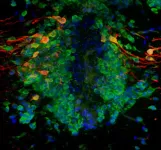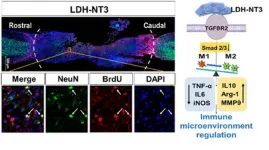(Press-News.org) A new study of mortality among young adults born prematurely includes 6.3 million adults under the age of 50 in Norway, Sweden, Finland and Denmark. Among this group, 5.4 per cent were born before term, according to Professor Kari Risnes at the Norwegian University of Science and Technology's (NTNU) Department of Clinical and Molecular Medicine and St. Olavs Hospital.
Researchers used national birth registers and compared them with the cause of death registers that all Scandinavian countries have.
"We already know that preemies have increased mortality in childhood and early adulthood. Now we've confirmed the risk of death from chronic diseases such as heart disease, lung disease and diabetes before the age of 50," says Risnes.
The professor doesn't want the numbers to scare people.
"It's important to remember that most people who are born prematurely do well, and that treatment and follow-up are constantly improving. The significance of the finding is that prematurity is something that follows you through life as a vulnerability to some diseases," Risnes says.
The study shows that the risk of preemies dying before the age of 50 is 40 per cent higher than for the population as a whole.
Researchers found that the risk of dying for individuals born before full gestation and who have chronic heart disease, lung disease or diabetes is twice that of the population as a whole. However, this group has no increased risk of death from cancer and stroke.
"We were surprised to see that the risk of death was higher even in people who were born as late as weeks 37 and 38, only a few weeks before full gestation. Although the extra risk was only about 10 per cent, this group makes up about 15 per cent of all births, and we have to try to map the causal relationships here," she said.
Risnes believes that the results from the study should be factored in when doctors assess the patient's risk of disease and their preventive advice for the patient.
"Our idea is that we should increase awareness in both the general population and among doctors so that the risk can be reduced. We need to recognize that prematurity is a factor to take into account when assessing risk, just like we do with a family history of heart disease, obesity or smoking," Risnes said.
"It's important to be aware of additional factors that increase the risk of cardiovascular disease and diabetes, like high blood pressure, obesity, inactivity and high blood sugar, plus the high levels of all these additional factors that we see more of in premature births," she says.
"These diseases are often preventable. Good treatment is important and can often longterm to maintain a good quality of life and avoid illness and death. We should be identifying lifestyle changes from an early age that reduce the risks, like more physical activity and avoiding obesity and smoking," Risnes said.
One question still to be answered is whether a greater number of premature versus full-term infants develop these chronic diseases, or if they are just generally less well equipped to survive the diseases.
"We need to try to address this question in the next round of research. It may be that the diseases crop up earlier in premature babies. We don't have data on this yet," Risnes says.
In the 1960s and 1970s, only 20 to 30 per cent of the most premature infants reached 15 years of age. Today, their survival rate is over 90 per cent. This means that the strong ones, the survivors, were preemies in Risne's study of adults.
"With better neonatal medicine, the proportion of the population born prematurely is growing," says Risne. She believes it will be important to follow this population closely in terms of risk. In the study, individuals born prematurely around 1980 had a slightly higher risk of cardiovascular disease than those born around 1970.
The study doesn't indicate that the social status of the mother or conditions of upbringing explain the increased risk of mortality. The researchers compared siblings to find out if the excess mortality was due to genetics or socioeconomic conditions.
"We found that risk of death for these diseases was higher for people born prematurely than for their full-term siblings. We concluded that the increased risk can't be fully explained by genes, which siblings have in common, or by socio-economic conditions and living conditions in childhood," says Risnes.
Dying in the first 50 years of life is rare. For 30-year-olds, the risk of dying is one in 1 000 per year, for 50-year-olds the risk rises to two in 1 000. Chronic diseases make up a minor percentage of these deaths. The researchers in the EU study chose to look at cancer, heart disease, stroke, chronic lung disease and diabetes because these are the most common chronic diseases that can be fatal.
In the past, it has been difficult to access other nations' health databases. Risnes is very happy that such access was possible for this study. Robust results are easier to attain with such a large volume of health data. The findings of the study are consistent between countries.
INFORMATION:
Reference: Kari Risnes, Josephine Funck Bilsteen, Paul Brown et al. Mortality Among Young Adults Born Preterm and Early Term in 4 Nordic Nations. JAMA Network Open.
An international group of researchers led by the University of Adelaide has conducted a comprehensive genetic analysis and found no evidence of interbreeding between modern humans and the ancient humans known from fossil records in Island Southeast Asia. They did find further DNA evidence of our mysterious ancient cousins, the Denisovans, which could mean there are major discoveries to come in the region.
In the study published in Nature Ecology and Evolution, the researchers examined the genomes of more than 400 modern humans to investigate the interbreeding events between ancient humans and modern ...
TALLAHASSEE, Fla. -- Scientists peering into the beating heart have solved a decades-old, fundamental mystery about how the heart works. The revelation could herald the development of new treatments for heart diseases -- the leading cause of death worldwide.
Researchers from Eastern Virginia Medical School, Florida State University and the University of Virginia have observed a tiny muscle filament during a crucial stage in a beating heart for the first time. The research was published in Proceedings of the National Academy of Sciences.
The heart is a unique muscle which contracts and relaxes about once every second ...
PROVIDENCE, R.I. [Brown University] -- The COVID-19 pandemic has had devastating effects in U.S. nursing homes and long-term care facilities, resulting in an estimated 1.2 million infections and 147,000 deaths as of early 2021. Yet even as mortality rates in the general population have decreased over time, little evidence has been uncovered to determine whether nursing home residences have experienced similar reductions.
Now, new data collected and analyzed by researchers at Brown University shows that mortality rates among nursing home residents with COVID-19 declined from March to November 2020, and that the deadliest ...
An international group of scientists from India and Russia has created edible food films for packaging fruits, vegetables, poultry, meat, and seafood. Films consist of natural ingredients, they are safe for health and the environment. In addition, films are water-soluble and dissolve by almost 90% in 24 hours. Description of the research and results of experiments are published in the Journal of Food Engineering.
"We have created three types of food films based on the well-known naturally occurring seaweed biopolymer sodium alginate," said Rammohan Aluru, senior researcher Organic synthesis laboratory at Ural Federal University and co-author of the paper. "Its molecules have film-forming ...
Recently, a published study in Science Advances assessed the contribution of pollinators to international market flows and showed that biodiversity conservation is essential to sustain global consumption patterns. This study results from the work of an interdisciplinary team that integrated researchers across the fields of economics, ecology, environmental sciences and social sciences.
Given the growing global demand for crops, sustainability in agriculture is one of the main challenges for human society. Together with the excessive use of chemical inputs, the loss of natural habitat associated with cropland expansion is one of the main drivers ...
Philadelphia, March 23, 2021 - Researchers from Children's Hospital of Philadelphia (CHOP) have discovered that a widely used nutritional supplement may significantly reduce the risk of fatal strokes caused by a rare genetic disorder. Additionally, the findings suggest that the supplement could be used to both block precipitation of and break up the formation of amyloid plaque deposits, a common feature found in serious forms of dementia. The findings were published online today by the journal Nature Communications.
The findings centered around a genetic disorder known as hereditary cystatin C amyloid angiopathy (HCCAA). HCCAA is part ...
Evolution of auroral substorms revealed by physicists at University of Warwick using the same methods that link people through social media
'If you like this magnetometer, you might like this one too:' historical data from magnetometers used to match them with 'like-minded friends' during 41 substorms
Shows that a single coherent electrical current, that accompanies the Northern Lights during substorms, covers most of the Earth's night-side at high latitudes
Will help to validate models used to predict auroral substorms, which can disrupt electronics and power distribution systems
Space weather often manifests as substorms, where a beautiful auroral display such as the Northern Lights is accompanied ...
A pioneering study, published in Scientific Reports, found that the Parkinon's gene PINK1 is important for the generation of dopamine-producing neurons throughout life, and is not just responsible for the premature death of these neurons
The international research, led by University of Sheffield's Neuroscience Institute, used two model systems to examine how neurons are produced throughout our lifetime
Parkinson's disease is a relentlessly progressive neurodegenerative disorder that affects around 145,000 people in the UK
A gene defect linked to Parkinson's disease may not only cause the early death of neurons, ...
Hennigsdorf/Berlin, Germany, March 23, 2021 - Diagnostics company SphingoTec GmbH ("SphingoTec") announced today the first published data (1) on the biomarker DPP3 that can predict the evolution of organ function and survival in septic patients. Measured on top of routinely used standard parameters, such as Lactate and Procalcitonin, DPP3 is an early indicator of short-term outcomes and patient severity. Sepsis is a medical emergency caused by a dysregulated host response to an infection, with mortality rates increasing rapidly for each hour that appropriate treatment is delayed (2). The rapid evolution of sepsis into its severe form, septic shock, raises the need for more precise and faster testing to support better clinical decision-making.
DPP3 is an ...
Researchers from the Department of Orthopedics of Tongji Hospital at Tongji University in Shanghai have successfully used a nanobiomaterial called layered double hydroxide (LDH) to inhibit the inflammatory environment surrounding spinal cord injuries in mice, accelerating regeneration of neurons and reconstruction of the neural circuit in the spine. The researchers were also able to identify the underlying genetic mechanism by which LDH works. This understanding should allow further modification of the therapy which, in combination with other elements, could finally produce a comprehensive, clinically applicable system for spinal cord injury relief in humans.
The ...





